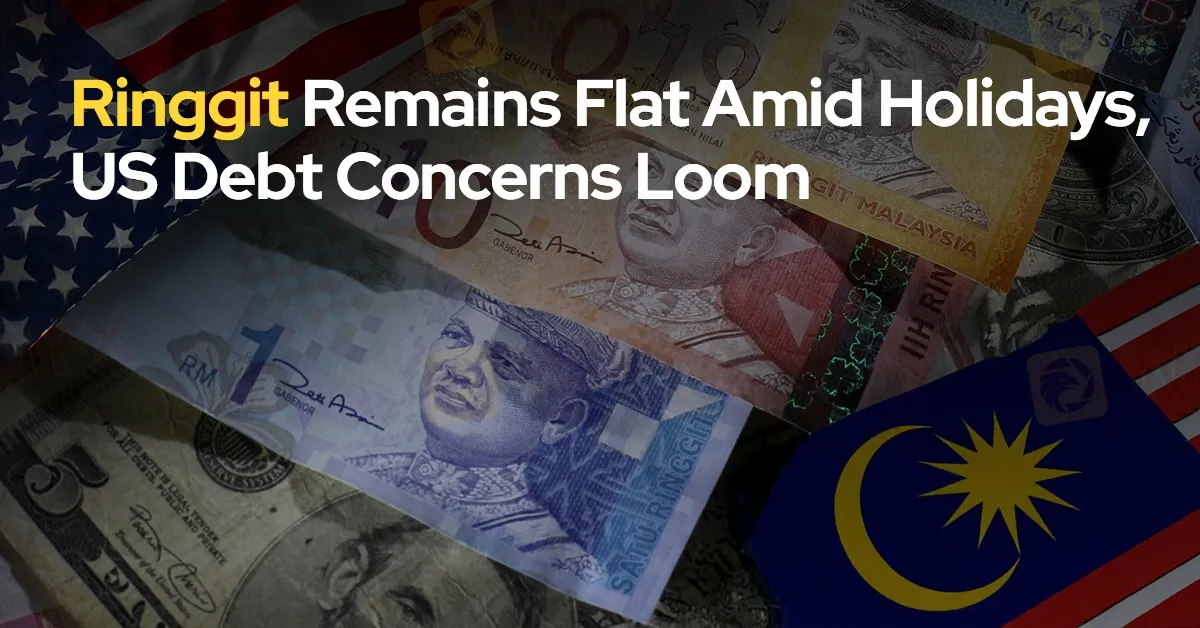简体中文
繁體中文
English
Pусский
日本語
ภาษาไทย
Tiếng Việt
Bahasa Indonesia
Español
हिन्दी
Filippiiniläinen
Français
Deutsch
Português
Türkçe
한국어
العربية
Ringgit Remains Flat Amid Holidays, US Debt Concerns Loom
Abstract:The Malaysian ringgit began the week steady against the US dollar, showing little movement due to a lack of market catalysts during the holiday-shortened trading week.

The Malaysian ringgit began the week steady against the US dollar, showing little movement due to a lack of market catalysts during the holiday-shortened trading week. The currency opened at 4.4680/4750 against the greenback at 8 am, mirroring its close from last Friday.
Market sentiment remains subdued, with attention focused on developments in the United States economy. Dr Mohd Afzanizam Abdul Rashid, Chief Economist at Bank Muamalat Malaysia Bhd, explained that the ongoing holiday period is keeping activity in the currency markets muted. He noted that concerns surrounding the US debt ceiling are dominating investor focus.
The economist highlighted a warning from the US Treasury Secretary that the government could reach its borrowing limit by mid-January. Recent political uncertainty over a potential government shutdown, combined with hawkish rhetoric from President Donald Trump and prominent businessman Elon Musk, has added to the unease. Dr Afzanizam observed that these issues might create challenges as the new US president prepares for inauguration on 20 January.
With these developments in mind, the ringgit is expected to trade within a narrow range, reflecting the cautious sentiment in the market.

The ringgit faced a mixed performance against other key global currencies. While it gained slightly against the Japanese yen, rising to 2.8296/8343 from 2.8300/8346 last Friday, it weakened against the British pound, sliding to 5.6199/6287 from 5.5904/5991. Similarly, it declined against the euro, ending at 4.6601/6674 compared to 4.6489/6574 previously.
The local note also showed varied performance within the ASEAN currency bloc. It weakened against the Singapore dollar, slipping to 3.2899/2955 from 3.2846/2900, and fell against the Thai baht, trading at 13.1196/1583 from 13.1023/1289.
However, the ringgit strengthened marginally against the Indonesian rupiah, improving to 275.1/275.7 from 275.4/276.1. Its position remained unchanged against the Philippine peso, holding steady at 7.72/7.74.

Disclaimer:
The views in this article only represent the author's personal views, and do not constitute investment advice on this platform. This platform does not guarantee the accuracy, completeness and timeliness of the information in the article, and will not be liable for any loss caused by the use of or reliance on the information in the article.
Read more

Is Amillex Safe or a Scam? Understanding Rules and Security
You are asking an important question: Is Amillex safe or a scam? The simple answer is that Amillex works in an unclear area that needs careful study. It is not a complete scam like fake websites that steal your money right away, but it also does not meet the safety rules of the best, well-regulated brokers. Read on to explore more details.

Amillex Broker Affiliate Program: A Complete Guide to Earning with Referrals
The Amillex Broker affiliate and partnership programs offer an excellent chance for people and businesses to earn steady income by referring new traders. Simply put, this is your opportunity to make money from your network, website visitors, or social media followers by working with a trusted, high-quality broker. This partnership gives you competitive payment rates, strong benefits for partners, and reliable support to help you succeed. This complete guide covers everything you need to know, from understanding how you can earn money to following a clear plan for increasing your income. We will show you how to turn your influence into steady and growing earnings.

Firsttrade Review: Traders Raise Ponzi-Style Scam Concerns, Withdrawal Denials & More Issues
Have you lost all your capital while trading via Firsttrade? Does the US-based forex broker disallow you from withdrawing funds? Do you have to pay massive fees when transferring funds? Does your trade get affected because of frequent malfunction in the trading app? These have been haunting many traders at Firsttrade. Consequently, many of them have raised complaints online. In this Firsttrade review, we have shared such complaints. Keep reading to know about them.

Defcofx Review: Spread Manipulation & Poor Customer Support Outrage Traders
Does the poor customer support service leave you stunned when trading via Defcofx? Do you receive blunt, negative responses from the support team on several trading queries? Does the Saint Lucia-based forex broker pile on the losses for you by manipulating forex spread charges? In this Defcofx review, we have shared some complaints made against the broker. This will further answer your question: Is Defcofx real or fake?
WikiFX Broker
Latest News
Is Nash Markets Regulated or Risk? Truth About Nash Markets’ License & Withdrawal Issues
Annual Sales Of New Vehicles Expected To Hit Only 15.7 Million Units: Cox
Amillex Broker Affiliate Program: A Complete Guide to Earning with Referrals
Saxo Bank Japan Expands European Stock Portfolio with UBS, Ferrari, and Other Major Names
New SC Rules Take Effect in November 2025: What’s Next for Finfluencers?
Is Amillex Safe or a Scam? Understanding Rules and Security
XM Broker Celebrates 15 Years with $35,000 Bonus Promotion
Morgan Stanley To Acquire EquityZen To Bolster Private Markets Reach
Currency Calculator



